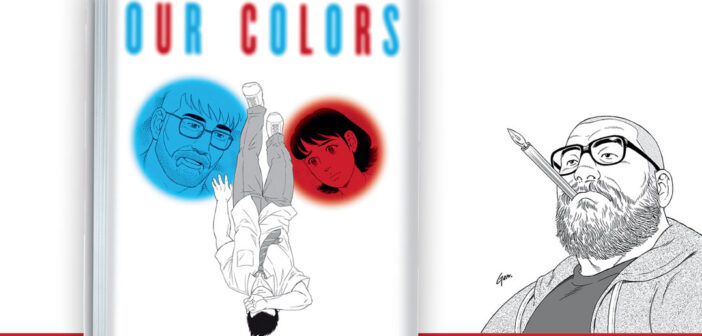There’s a point in Gengoroh Tagame’s Our Colors when the story’s protagonist, Sora Itoda, is consumed by all the fears and anxieties of his closeted sexuality. And it’s then that Sora visualizes a series of closed doors in his mind.
“Who’s next? No one comes out just once,” Sora says to himself in that moment of imagination.
This is the ever-present question throughout Our Colors, as our main character guides us through his life lessons in accepting his sexuality and choosing who to reveal it to, when, and under what circumstances.
It sounds like a tired trope in 2022. How many times can a coming-out story be told? Well, that all depends on the mastery of the storyteller embarking on the story in question. And here, Gengoroh Tagame is completely on point—as he always is.
It is rare for a creator to always be so precise, authentic, and natural in all of his work, but Tagame is one of those rare creators.
Since Our Colors follows the usual overarching beats and themes of a coming-out story, there are some expected plot developments that are far from spoilers. Sora Itoda, as our main character, deals with everything you’d expect of a high-school student. His horned-up buddies are obsessed with girls, his longtime female friend has maturing and complicated feelings for him, and Sora (in turn) has complicated feelings for a long-time male friend. Worst of all, his parents are unbearably nosey and controlling in the eyes of a closeted gay high-school student.
See? We’ve all been there.
But fear not, because none of it is trite. Gengoroh Tagame is a writer and artist of subtle tact, and there are plenty of small flourishes to help readers quickly identify with Sora and see the world and the arc of the story from his perspective.
When Sora’s young world grows so smothering that he can’t handle it anymore, he flees to the beach where he throws himself on a bench, closes his eyes, and pretends that the world no longer exists.
Enter Shirow Amamiya, who sees the zoned-out Sora and remarks to himself, simply: “How surprising to find you here. I’ve always wanted to tell you that I love you.”
Mr. Amamiya casually walks away, leaving his comment lingering in the air. But it startles Sora out of his trance, and he looks around for the man who spoke the words. He’s no where to be found. This is what begins Sora’s quest of discovery, for hearing one man speak of romantic love for another man was something he didn’t truly believe possible.
The name Gengoroh Tagame is only recognizable if you know where to look. He’s been around the Japanese manga scene for years now as the premier artist of gay-themed “bara” manga, as it’s called in the west. But as Tagame revealed in an interview featured in Massive: Gay Erotic Manga And The Men Who Make It from Fantagraphics Books, he dislikes the term and does not use it, as it carries a pejorative meaning in gay Japanese culture.
But to refer to the body of work belonging to Gengoroh Tagame as “gay-themed” and “erotic” is putting it incredibly lightly. Tagame has created a milieu all his own—one rife with a BDSM spirit amongst burly men sporting tight crewcuts and thick beards. But to assume his stories are tawdry would be a foolish error. For Tagame goes well beyond shock-value NSFW content to instead explore the sexual psyche of gay men in these scenarios of domination and submission. What makes these men tick? What makes them crave this activity? These insights are always handled with the deft care Tagame brings to all of this stories.
Sometimes his stories even have a dose of heart, such as in Fisherman’s Lodge, which was published by Bruno Gmunder for English-speaking audiences in 2016. And, of course, Our Colors, which I’d say is all heart, since there’s not one iota of pornographic content in the book. There’s no need for it in a story like this.
Our Colors wants to look at the emotional side of a young gay man’s sexuality as he grapples with who he is, and how he finds platonic guidance in the form of a mentor. And here, the mentor is played by Mr. Amamiya. Also helping Sora along his journey of self-discovery is his childhood best friend, Nao Nakamura. She and Mr. Amamiya form a united front in providing Sora the support he needs when he needs it, even is Nao is struggling with some feelings of her own.
In a brief afterward, Tagame says that this book was written for his “15-year-old” self who existed “42 years ago.” Tagame didn’t have a Mr. Amamiya then, so he’s making up for it now with Our Colors. The book’s understanding of the emotional turbulence that comes with closeted sexuality demonstrates the wisdom of age and experience Tagame has earned.
Interestingly, the character of Mr. Amamiya reminds me of a subject from Alan Downs’ The Velvet Rage. Toward the end of the book in Chapter 11, Downs describes a man named “Chase,” who left behind his life of material success in New York City to cultivate authenticity far away from his comfort zone. Chase landed in Key West where he bought a rundown diner. At the time of the book’s writing, Downs reported that Chase was running a successful—albeit small and humble—bistro. Most importantly, Chase was happy.
This is Tagame’s second PG-rated story printed in English. His other, the two-part My Brother’s Husband, was published in 2017 and 2018 from Pantheon Press (also the publisher of Our Colors).
An important theme in Our Colors focuses on personal conduct. How we behave shapes the lives we live. Those choices amass over a lifetime, and you will eventually look back upon them with either satisfaction or regret.
We cannot control how people receive us or the choices we make, nor do we have a right to.
But we do have a right to controlling how we conduct ourselves.
This review originally appeared on a Lucas Digital Content-affiliated website September 2022.




